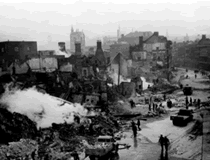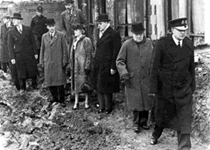


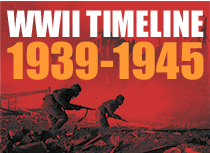


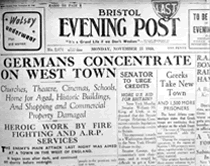
Propaganda during the war was managed by the Ministry of Information. The press were given precise instructions on how to handle war stories. Because of the risk of spreading information to the enemy, Bristol had to be referred to as ‘a West Town’ in early news reports and Avonmouth was ‘a docks area’. Photos and stories were censored if they were likely to undermine morale. The book West at War, which captures the voices of West Country people who experienced life on the domestic front line, says that the ‘newsreels, films, plays, books, magazines and newspapers’ of the time could only portray ‘a Britain that was brave, cheerful, hard-working, and optimistic’. Some of the pictures taken for the Bristol Evening Post by the photo-journalist Jim Facey, for example, were rejected by the censor because they showed injured people, dead bodies, blitzed churches and unhappy faces. The mythologizing proved very effective and the bungling, panic and heartache are remembered less well than the camaraderie, defiance and good humour of the people. The authors write in the introduction to West at War:
The reality was far more heroic: underfed, poorly clothed, terrified and exhausted men, women and children who, at the worst times, came to the very threshold of defeatism but found that extra ounce of courage to pull themselves back from despair.
The seriousness of the war situation was brought home to many when some of the bedraggled survivors of Dunkirk arrived in Bristol in June 1940. With the fall of France, the threat of air raids grew. The city was a strategic target because it was home to the Bristol Aeroplane Company, Avonmouth Docks, shipbuilding and engineering facilities, and a transport hub. There were minor raids and false alarms following the declaration of war but a daylight raid on Filton on 25 September 1940 shook people’s confidence and heralded worse to come.
The first raid of what became know as the Bristol Blitz took place on November 24 1940. It centred on the area around Bristol Bridge but bombs also hit residential areas including Bedminster, Knowle, St George and Clifton. The city was still unprepared, ill-equipped and inexperienced. During that attack 10,000 homes were damaged, 207 people were killed, 187 seriously injured and 1,400 made homeless. ‘Nothing would be the same again. Bristol never took an air raid warning lightly after that black Sunday.’
A woman trapped at the Colston Hall during the raid who walked to Bedminster the next morning, recalls what she saw:
The walk through the city was, well, I don’t think anybody could describe it. There were buildings falling down, there were rescue operations going on with all the people buried, there was water gushing in the streets, there were gas mains going. You had to pick your way through where you could get through. But there were fires and the smell of gas and people shouting and screaming. And crowds of people huddled about with blankets over them and ambulances running here, there and everywhere. It was terrible.
The worst raid on the city came on 16 March 1941. It lasted from 8.27pm to 4.15 am the following day, and 257 people were killed. Property was damaged in Temple Meads, Lawrence Hill, Easton and Eastville, Whitehall, St Pauls and Montpelier, Knowle, Fishponds, Cotham, Redland, Clifton. The destruction of three buses in Broad Weir by an undetected single German raider on 28 August 1942 left 45 dead and was particularly traumatic as the city had come to think it was now safe from attack.

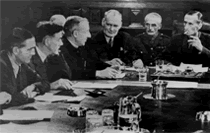
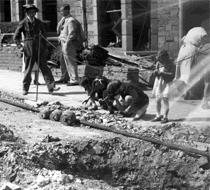
Children looking for shrapnel after raid
